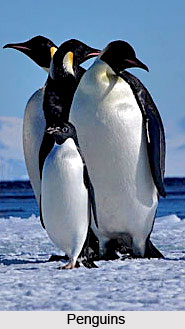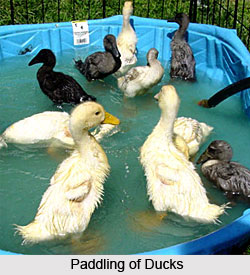 What generally comes into ones mind when one thinks of `birds`? A soft-bodied creature, which lays eggs, which can fly great distances, found in a variety of species and various colors, having a beak instead of a normal mouth. Well, there is obviously more to Birds than the former mentioned points.
What generally comes into ones mind when one thinks of `birds`? A soft-bodied creature, which lays eggs, which can fly great distances, found in a variety of species and various colors, having a beak instead of a normal mouth. Well, there is obviously more to Birds than the former mentioned points.
Birds are warm-blooded bipedal vertebrates characterized by bony beaks, hollow bones, feathers and forelimbs modified as wings. They lay hard-shelled eggs. Being a warm-blooded creature, their body is covered with insulating feathers to maintain an even temperature. The size of the birds can vary from the tiny flowerpeckers & hummingbirds, to the huge Ostrich and the Sarus Crane. In India, other than the Sarus Crane, the Himalayan Bearded Vulture or Lammergeier is the biggest bird and the tiny Tickell`s Flowerpecker is hardly bigger than a human thumb!
Most birds can fly. Most birds can walk and run and, many can swim and dive. Migrating birds can fly great distances. Migration takes place with change in seasons to maximize feeding hours and/or to breed in suitable habitats. Arctic Terns migrate twice every year from Arctic to Antarctica and back (over 15,000 km one way!). Some birds, like the Wandering Albatross, spend most of their time at sea. Some, such as frigatebirds, stay aloft for days at a time, even sleeping on the wing. Some larger birds like Penguins, Ostrich and Kiwi are flightless.
The expanded and elongated pelvis of all birds is fused rather than articulated to the vertebrae. The bird ancestor`s bipedal stance caused the forelimb to evolve into a wing that is structurally independent of the legs. This has helped birds to evolve in such a way as to free the legs for perching, walking, running, swimming and, catching and manipulating prey. To aid in flight, birds have a different respiratory system as compared to mammals. In the absence of a diaphragm, air sacs act as a `bellows` to ventilate the lungs. The lungs are small, with "air capillaries" through which air is drawn into a system of air sacs beyond the lungs. A bird`s "aerobic capacity" is determined by the capacity of its heart and lungs. Only Hummingbirds have sufficient aerobic capacity to hover continuously, although many small birds can hover non-aerobically for short periods. Some large birds have insufficient aerobic capacity for sustained level flight at any speed, and are forced to soar. Flying, birds lose heat by sending blood to thinly insulated areas of skin that are exposed to the airflow.
 As everyone knows, birds lay eggs -- specifically, they lay very typical amniote eggs with calcified shells. Birds brood their eggs until hatching. Some bird species are naked and helpless at birth, and must be fed by their parents; these birds are said to be altricial. Many common songbirds, such as the American robin, are altricial species. Precocial birds, on the other hand, are born feathered, and are able to walk and to feed on their own shortly after hatching -- ducks and chickens are well-known precocial birds. Whether precocial or altricial, birds grow rapidly, reaching adult size within one year.
As everyone knows, birds lay eggs -- specifically, they lay very typical amniote eggs with calcified shells. Birds brood their eggs until hatching. Some bird species are naked and helpless at birth, and must be fed by their parents; these birds are said to be altricial. Many common songbirds, such as the American robin, are altricial species. Precocial birds, on the other hand, are born feathered, and are able to walk and to feed on their own shortly after hatching -- ducks and chickens are well-known precocial birds. Whether precocial or altricial, birds grow rapidly, reaching adult size within one year.
Birds have a keen eyesight and good hearing but their sense of taste and smell is poor. Birds are generally diurnal (active during the day), some are nocturnal (active during the night), some crepuscular (active during twilight hours) and some nocturnal & crepuscular both. Bird food includes honey, nectar, seeds, grains, vegetable matter, insects, larva, spiders, fish, molluscs, rodents, reptiles, small mammals, carrion or other birds. Birds lack teeth, and the jaws are covered by a horny beak, which often shows adaptation to the bird`s particular diet: long, slender beaks for probing for insects, flat or paddle-shaped beaks for sieving food out of the water, heavy beaks for cracking and crushing seeds, or sharp, hooked beaks -- like that of the vulture depicted at right -- for tearing flesh.
Various scientific research and classifications show that there are over 9000 species of birds, as of today. Of these almost 1250 of the various species are found in India. Hunting of rare species, either for collection or sadistic pleasure of humans or for insatiable hunger, has led to extinction of a number of rare and beautiful species of birds. Birds are brought from their native places to be kept in a zoo or used in a circus or used for any other form of human entertainment. This kind of treatment disturbs the ecological balance of nature. Birds removed from their habitat are not able to adjust to the new habitat and they soon die. Almost 150 of them have become extinct after the human intrusion.
Usefulness of Birds:
Birds are remarkably important, and play a vital role, within their ecosystem, as well as for the environment as a whole. Birds are sensitive indicators of biological richness and the health of our environment. Birds play a vital role in our natural ecosystem. Birds have direct and indirect economic and cultural values for people. Because few humans care enough to acknowledge and appreciate birds` deep intelligence and feelings, these animals suffer terribly. If more people appreciated how rich and complex birds` lives are in the wild, humans` exploitation of birds, fuelled by the illegal "pet" trade, would decrease. In their natural habitats, birds talk to each other just as humans do. Some bird species, such as crows, have hundreds of different calls that ornithological researchers can tell apart. Birds also make sounds that we don`t usually hear, like the hushed chatter and whispering between two nesting birds. They take turns talking, just as we do in conversation.
Birds are beautiful and inspirational, a source of happiness and pleasure for people everywhere. Birds` herald the seasons, from arriving swallows in spring, cookcoo sounds in summer, to visiting waders and departing visitors in autumn and winter.
 Birds, through the ages have been source of considerable fascination and folklore and have profound symbolic potency. They are arguably the most universally celebrated from of nature, found in pictures, photographs, sculptures, word and song. The song of birds` gives humans great pleasure and also inspires humans to write their own songs, poetries and stories, to draw, paint and sculpt their likeness. Birds bring humans close to nature.
Birds, through the ages have been source of considerable fascination and folklore and have profound symbolic potency. They are arguably the most universally celebrated from of nature, found in pictures, photographs, sculptures, word and song. The song of birds` gives humans great pleasure and also inspires humans to write their own songs, poetries and stories, to draw, paint and sculpt their likeness. Birds bring humans close to nature.
Birds provide a means to improve our scientific knowledge and understanding of our environment. Birds are ideal for promoting conservation and environmental awareness, both as a species in their own right, and the habitats they share with other flora and fauna.
Birds play important roles in the control of insects and, perhaps more importantly, in the pollination and dispersal of flowering plants. A number of flowering plants have flowers, which are structurally modified for bird pollination. These flowers typically are colored bright red, which is visible to birds, and produce large quantities of sugar-rich nectar on which the visiting birds feed. Nectar sippers, like the Ruby Throated Hummingbirds, help pollinate the flowers they visit for nectar. Insect and invertebrate eaters, like woodpeckers, help keep down large populations of insect pests. Large Carnivores like the Red Tailed Hawk help keep down the populations of mice, voles, rabbits, squirrels, and fish. Waterfowl like ducks, geese and swans, keep down populations of amphibians (frogs, toads, and tadpoles)- therefore- maintaining ecological balance. Scavengers such as turkey vultures, crows and bald eagles, keep our forests; parks, streets and rivers clean by eating the dead animals they find.
In addition to pollination, birds are important dispersers of many plant seeds. These plants ripen fruits, which again are a bright red, and have thick coats on their seeds to protect them should they be swallowed. Seed, berries and fruit eaters help distribute tree seeds and weed and wildflower seeds. Waterfowl distribute seeds of water plants. Other birds or animals can eat almost all birds. Birds are an important part of the food chains of many animals including humans!
Bird Migration:
Bird Migration, or undertaking seasonal journeys of various lengths, is a natural phenomenon found universally in various species of birds. In India and South Asia, out of over 2000 species and sub-species, about 350 are extralimital migrants. Generally, in birds, migration is seasonal, and in the Indian subcontinent the majority of migratory birds are winter migrants. Migration of birds can be classified into:
1. Permanent residents, or just "residents," which are non-migrating birds who remain in their home area all year round.
2. Summer residents are migratory birds, which arrive north during the summer, and return south to wintering grounds in the fall.
3. Winter residents are migratory birds that have "come south" for the winter.
4. Transients are migratory species who can be seen only during the migratory period.
 Birds generally begin migration when they have a favorable tailwind. Once started however, only very bad weather will stop them. Many birds fly high when migrating because of prevailing winds at higher altitudes and also because the cold at these altitudes helps them disperse heat being generated by their flight muscles.
Birds generally begin migration when they have a favorable tailwind. Once started however, only very bad weather will stop them. Many birds fly high when migrating because of prevailing winds at higher altitudes and also because the cold at these altitudes helps them disperse heat being generated by their flight muscles.
Migrations mostly consist of birds flying south for the winter and north in spring to breed. To a large extent this reflects the distribution of the continents on the planets. There is a lot more temperate and tundra landscape in the north than in the south. During northern winters there`s little food, and cold temperatures make life hard. Farther south, there`s more food and less cold. The Mediterranean and other seas present a major obstacle to soaring birds, which are forced to cross at the narrowest points. Other barriers, such as mountain ranges, can also cause funnelling, particularly of large diurnal migrants. many species move shorter distances, but may do so only in response to harsh weather conditions.
Thus mountain and moorland breeders, such as Wallcreeper and White-throated Dipper, may move only altitudinally to escape the cold higher ground. Other species such as Merlin and Skylark will move further to the coast or to a more southerly region.
There are a few species, notably cuckoos, which are genuine long-distance migrants within the tropics. An example is the Lesser Cuckoo, which breeds in India and spends the non-breeding season in Africa.
In the high mountains, such as the Himalayas and the Andes, there are also seasonal altitudinal movements in many species.



















